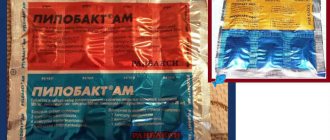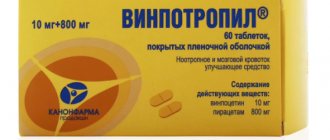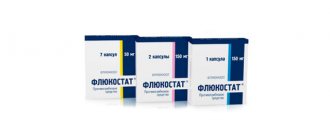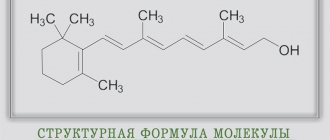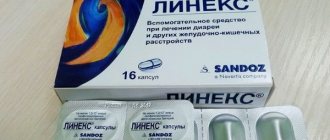1
29305
Author of the article
Evgeniy Nikolaevich Konoplev
Reading time: 6 minutes
AA
When suffering from arthrosis and arthritis, patients experience pain. To get rid of them they use various medications. Flamax for injections is considered an effective way to eliminate pain. The drug quickly improves the condition. It is often prescribed as an analgesic, antipyretic and anti-inflammatory agent.
Compound
Flamax capsules (1 capsule) contain the active ingredient ketoprofen (50 mg), as well as additional substances: MCC, lactose monohydrate, sodium lauryl sulfate, croscarmellose sodium, colloidal silicon dioxide, povidone.
Flamax Forte tablets contain 100 mg of the active ingredient ketoprofen (1 tablet), as well as additional ingredients: rice starch, lactose monohydrate, croscarmellose sodium, colloidal silicon dioxide, MCC, povidone, sodium lauryl sulfate, macrogol 6000, magnesium stearate, hypromellose, talc, titanium dioxide
Flamax in the form of a solution in one ampoule (2 ml) contains 100 mg of ketoprofen . The composition also includes additional substances propylene glycol, benzyl alcohol, ethanol, sodium hydroxide, water for injection.
Features of the composition
The drug Flamax, used for injections, is available in ampoules with liquid for injection. This preparation is usually clear but may have a color ranging from colorless to faint yellow. Each ampoule contains 2 ml of liquid, packaged in plastic trays, each of which will contain 5 ampoules. Pallets are packed in a cardboard box in quantities of 1 or 2 pieces. Therefore, the total number of dark glass containers in a package is 5 or 10 units.
Being a non-steroidal anti-inflammatory drug, Flamax (injections) is intended for intramuscular administration in the early stages of disease treatment. The solution contained in ampoules can also be administered through a vein. In addition, there is a release form in the form of tablets, which are recommended for use in subsequent stages of treatment.
The active ingredient is Ketoprofen, a derivative of propionic acid with an analgesic effect. Its content in 1 ml of solution is 50 mg. Auxiliary components of the drug are ethanol, benzyl alcohol, as well as sodium hydroxide with propylene glycol, water for injection.
Release form
Flamax is available in the form of capsules, a solution for intravenous and intramuscular administration, rectal suppositories, lyophilisate for subsequent preparation of the solution, tablets, capsules.
Flamax capsules have a white body and a blue cap; inside there is a white powder that has a uniform consistency.
The solution is contained in 2 ml ampoules with a colored break ring or notch. The blister pack contains 5 ampoules.
Flamax Forte is available in the form of biconvex round blue tablets, which are film-coated. The blister contains 10 tablets, 2 blisters are placed in a cardboard box.
Flamax Forte capsules are contained in a plastic container, which is placed in a cardboard pack.
Flamax cost
The solution in ampoules is dispensed only with a doctor's prescription. Depending on where you live, the average cost of Flamax for injections will vary. The price is about 250 rubles for 10 2 ml ampoules with a concentration of 50 mg of the main component.
Some drugs have a similar effect. They also contain the main active ingredient ketoprofen. Structural analogues include:
- Ketonal;
- Artrum;
- Ketoprofen;
- Valusal;
- Profenid.
Only the attending physician selects a similar medication. He will be able to indicate the exact dosage and duration of treatment with the replacement drug.
Pharmacodynamics and pharmacokinetics
Ketoprofen binds to blood proteins in the body by 99%, mainly to albumin. The highest concentration of the substance in plasma is achieved relatively quickly. Ketoprofen quickly penetrates into connective tissue and synovial fluid. 15 minutes after a single injection of the drug intramuscularly, a high concentration of the active substance is observed in the synovial fluid. It lasts up to 30 hours, so it is possible to reduce pain and stiffness in the joints for a long period of time. It does not penetrate the BBB in significant quantities.
Metabolism of ketoprofen occurs mainly in the liver. There the glucuronidation process takes place, after which esters and glucuronic acid are formed. They are then excreted by the kidneys. The half-life of ketoprofen ranges from 1.6 to 1.9 hours.
Pharmacological properties
The main substance in Flamax, ketoprofen, is distinguished by its ability to inhibit active enzymes in the body that are responsible for inflammation. When it gets inside, it begins to interact with albumin and plasma proteins. The main component actively penetrates liquid and tissue.
After about 15 minutes it reaches its maximum effect. Over the next half hour, ketoprofen works very actively, reducing pain and inflammation in the body. It does not accumulate in tissues, and its biotransformation occurs in the liver. It is excreted through the kidneys and only 1% finds its way out of the intestines. The substance significantly reduces inflammation and stiffness of joints and provides an analgesic effect.
Indications for use
The medicine Flamax and Flamax Forte are used for the symptomatic treatment of pain and inflammatory processes of various origins at moderate intensity:
- diseases of the human musculoskeletal system ( arthritis , rheumatic soft tissue lesions , ankylosing spondylitis , osteoarthritis );
- sciatica , neuralgia , lumbago ;
- migraine , pain after surgery;
- painful menstruation , inflammatory processes in the pelvic organs;
- pain and inflammation after injuries;
- toothache;
- pain due to cancer.
Reviews about Flamax
The drug has a good analgesic effect, which is confirmed by reviews of Flamax on medical websites and forums. Quite often, capsules and injections of the drug are used to relieve pain in the postoperative period. The drug Flamax is often used for back pain, osteochondrosis and other diseases of the musculoskeletal system, for which its effectiveness has also been proven repeatedly.
Some patients noted weakness and drowsiness after the injection, while others found the effect of the drug weak (it only worked after the second injection).
Contraindications
Flamax is not used in the following cases:
- high sensitivity;
- period of exacerbation of ulcers and erosions of the gastrointestinal tract;
- exacerbation of inflammatory bowel diseases;
- bleeding from the gastrointestinal tract;
- acute period of kidney disease, severe form of liver failure.
- hyperkalemia;
- progressive kidney disease;
- a combination of recurrent nasal polyposis or bronchial asthma with intolerance to NSAIDs, in particular acetylsalicylic acid;
- disorders of hemostasis , hematopoiesis ;
- after coronary artery bypass surgery ;
- third trimester of pregnancy and breastfeeding;
- The patient's age is up to 15 years.
The medicine is used with caution for arterial hypertension , bronchial asthma , edema, chronic heart failure , sepsis , diabetes mellitus , renal failure , coronary artery disease, and severe somatic diseases.
Flamax injections and tablets: indications, contraindications and side effects
The medication Flamax injections is produced in the form of a solution that is injected into a muscle or into a vein. 1 ml of the drug contains ketoprofen, additionally included water for injections, ethanol, benzyl alcohol. Regarding the form of the drug Flamax - tablets, the main substance is the same as in the case of the solution. They are produced in the form of Flamax Forte 100 mg, which are film-coated. Indications for use.
In the form of injections, the medicine is prescribed by the attending physician according to a medical examination in case of diseases:
- migraine;
- neuritis and neuralgia;
- sciatica;
- toothache;
- lumbago;
- pain syndrome after surgery;
- arthritis of various origins;
- menstrual cycle with severe pain;
- rheumatism;
- osteoarthritis;
- ankylosing spondylitis;
- adnexitis.
Flamax tablets are also taken if the following diseases are established:
- to relieve pain from otitis media, bursitis, neuralgia;
- to suppress pain during arthralgia, headache, myalgia.
Contraindications
Taking Flamax injections and tablets is not prescribed in cases where the patient is diagnosed with:
- Erosion and ulcers of the gastrointestinal tract, especially in the acute phase of the disease.
- Bleeding in the gastrointestinal tract.
- Inflammatory processes of the intestines.
- Liver failure or organ ailments.
- Kidney diseases.
- Bronchial asthma.
- Hematopoiesis disorder.
- Pregnancy, particularly in the third trimester.
- Children under 15 years old.
- Hypersensitivity to components.
Side effects
When taking the drug Flamax, side effects from various systems and organs may develop. Liver dysfunction, nausea, diarrhea, loss of appetite, stomatitis. If Flamax injections are used for a long time and excessively, bleeding may occur, in which case the doctor may prescribe Konakion. Pain in the head, insomnia, excessive excitability, depression, migraine, forgetfulness.
Noise in the ears, decreased clarity of visual perception. Rarely, tachycardia may develop; more often, an increase in blood pressure occurs. Cases of anemia, leukopenia, and agranulocytosis are very rare. Basically, swelling of the urinary organs; cases of urethritis and cystitis remain rare.
Skin rashes in the form of urticaria, itching, angioedema, dermatitis. Profuse sweating, less frequent nosebleeds, coughing up blood, shortness of breath, muscle twitching; if taken for a long period of time, vaginal bleeding may occur.
Side effects
The following side effects may occur:
- Digestive system: dyspepsia , abdominal pain, changes in taste, liver dysfunction, stomatitis, changes in taste. With prolonged treatment with large doses of drugs, bleeding of the gastrointestinal tract, gums, and the appearance of ulcers on the gastrointestinal mucosa is possible.
- Nervous system: insomnia , headache , nervousness, dizziness , migraine, symptoms of drowsiness or increased excitability, memory impairment.
- Sense organs: blurred vision, ringing in the ears, pain and dry eyes, hearing loss, conjunctival hyperemia .
- Cardiovascular system: tachycardia , increased blood pressure.
- Hematopoietic organs: anemia , agranulocytosis , leukopenia , thrombocytopenia .
- Urinary system: cystitis , urethritis , renal dysfunction, nephritis , hematuria .
- Allergic manifestations: rash, itching of the skin, swelling, rhinitis , bronchospasm , dermatitis .
- Other manifestations: hemoptysis , severe sweating, muscle twitching, shortness of breath, myalgia, nosebleeds. When treated with large doses of the drug, vaginal bleeding is possible.
Special cases
To avoid injuries due to a decrease in concentration and reaction speed after injections, it is necessary to avoid working with units and mechanisms, and to refuse to drive a car as a driver.
The drug may have a masking effect during the development of certain infectious diseases. In this regard, therapy is carried out with parallel monitoring of the blood condition and changes occurring in the functioning of the kidneys and liver.
If the patient is prescribed additional examinations of 17 ketosteroids, then treatment with Flamax injections, as well as taking the drug in other forms, should be stopped. This must be done no later than 2 days before the day of the scheduled examination. If this recommendation is violated, the results obtained will most likely be unreliable. Therefore, they will have to be repeated with a delay in the treatment of the disease, which can bring additional inconvenience to patients.
Instructions for use of Flamax (Method and dosage)
If a patient begins treatment with Flamax, the instructions for use should be carefully studied.
Injections (solution) are administered intravenously and intramuscularly. Intravenous administration is carried out exclusively in a hospital. On average, the infusion lasts 0.5–1 hour, maximum 48 hours. The dose of the medicine should not be higher than 300 mg. For a short infusion, 100–200 mg of the drug is diluted in 100 ml of 0.9% sodium chloride solution, the administration lasts no more than 1 hour. The next time the drug can be administered after 8 hours. For continuous infusion, 100–200 mg of the drug is diluted in 500 ml of solution for infusion, the administration lasts 8 hours. The next time you can administer the drug after 8 hours.
Flamax is administered intramuscularly at 100 mg 1–2 times a day.
Flamax capsules should be taken orally during meals. The dosage is prescribed by the doctor depending on the course of the disease. The maximum dose per day is 300 mg.
Instructions for use of Flamax Forte stipulate that the tablets should be taken orally during meals. As a rule, 1 tablet is prescribed 2-3 times a day. The permissible daily dose is 300 mg.
Interaction
When treating any other drugs together with Flamax, you should always consult your doctor before starting therapy.
If Flamax and loop diuretics , the nephrotoxic effect of these drugs increases. Flamax reduces the effectiveness of uricosuric drugs, but increases the effect of anticoagulants , ethanol , fibrinolytics , antiplatelet agents , as well as the manifestation of side effects when taking corticosteroids and mineralocorticosteroids , estrogens .
Flamax reduces the effectiveness of antihypertensive drugs and diuretics.
When used simultaneously with GCS , other NSAIDs , corticotropin , ethanol , gastrointestinal bleeding, ulcers, and renal dysfunction may occur.
The risk of bleeding increases when taken simultaneously with heparin , anticoagulants , thrombolytics , antiplatelet agents , cefoperazone , cefamandole , cefotetan .
When treating with Flamax, the doses of insulin and other hypoglycemic drugs should be recalculated, since their hypoglycemic effect increases.
Concomitant treatment with sodium valproate leads to a decrease in platelet aggregation.
Increases the concentration of nifedipine , verapamil , lithium preparations, methotrexate in the blood plasma.
Increases the hematotoxicity of myelotoxic drugs.
Absorption of the drug is reduced when taking cholestyramine and antacids simultaneously.
When Tramadol and Flamax are mixed in one bottle, a sediment forms.
special instructions
If treatment with Flamax and Warfarin or lithium preparations , strict monitoring by the attending physician is necessary.
Flamax can mask signs of infectious diseases.
During therapy, it is important to monitor peripheral blood parameters, as well as the activity of the liver and kidneys. If their functions are impaired, the dose should be reduced and the patient should be closely monitored.
To reduce the likelihood of developing side effects from the gastrointestinal tract, you need to use minimal doses of the drug and not practice long-term treatment.
If 17-ketosteroids , Flamax is canceled 48 hours before the test.
It is important to consider that concentration may deteriorate during treatment with the drug, so you should drive carefully and perform other potentially dangerous work.
The drug Flamax: terms of sale and storage, special instructions, reviews, prices
The specialist, according to the examination, prescribes a course of treatment, which includes the drug Flamax.
Depending on the clinical picture obtained and information about previous diseases, the patient receives treatment, which must be strictly followed.
Terms of sale
The drug Flamax is available only by prescription.
Storage conditions
Stored in a dry place at an air temperature not exceeding 25 degrees. A prerequisite is that it should not be accessible to children.
Best before date
Flamax is valid for 3 years from the date of release.
special instructions
When treated immediately with Flamax and Warfarin (or other lithium medications), it is necessary to monitor the treatment process, this is done by a doctor. The medicine can mask the symptoms of infectious diseases. When carrying out therapy with Flamax, it is mandatory to monitor the functioning of the kidneys, liver, and peripheral blood. If the functioning of these organs is impaired, the dose should be reduced.
To avoid disturbances in the gastrointestinal tract, it is important not to use long-term treatment and take the smallest possible doses. Concentration during treatment may weaken; this should be taken into account if driving a car or working at potentially dangerous objects is required.
Analogs
Any change in medication must be made by a doctor.
The drug Flamax has the following analogues:
- Flexen;
- Artrum;
- Ketonal;
- Artrosilene;
- Arketal et al.
Reviews
Tatyana, 48 years old, salesperson. “The doctor diagnosed rheumatism and prescribed Flamax for me in combination. I want to say that it relieves pain quickly, but the disadvantages include the short duration of its effect. That is, we can say that it relieves pain temporarily. Stomach upsets were also not uncommon as a side effect.”
Ivan Nikolaevich, 54 years old, turner. “The other day I tore my back and couldn’t stand up or straighten up. I had to call an ambulance. I was given a Flamax injection and within 15 minutes I was at least running. True, after 5-6 hours I felt pain again. I went to the doctor and they prescribed a course for 7 days. During this time I tried to move less. But after a week I felt an excellent result. Now I’ll be more careful, and, of course, I’ll buy some injections for my home medicine cabinet, just in case.”
Analogs
Level 4 ATC code matches:
Artrum
Brustan
Ketonal Duo
Nurofen Plus
Nurofen Express
Nurofen Forte
Nurofen Express Lady
Nurofen for children
Nurofen
Ibuprom
Ibuprofen
Advil
Mig 400
Has
Ketoprofen
Vimovo
Naproxen
Flexen
Nalgesin
Novigan
Analogs of Flamax and Flamax Forte, which are sold in pharmacies, are the drugs Ketonal , Flexen , Artrosilene , Ketospray , Ketonal uno , Arketal , Artrum , Profenid , etc.
All analogues have the same effect on the body as Flamax, but the decision on the final choice of drug should be made only by a doctor.
Flamax price, where to buy
The price of Flamax ampoules is on average 120 rubles. per pack 5 pcs. The cost of capsules is 100-120 rubles. per pack 25 pcs. The price of Flamax Forte is 120-150 rubles. (tablets in a package of 20 pcs.).
- Online pharmacies in RussiaRussia
ZdravCity
- Flamax capsules 50 mg 25 pcs. Replek Pharm LLC Skopje/ZAO PharmFirma Sotex
99 rub. order - Flamax solution for intravenous and intramuscular injection. 50mg/ml 2ml 5 pcs. JSC "Pharm"
138 RUR order
- Flamax solution for intravenous and intramuscular injection. 50mg/ml 2ml 10 pcs. JSC "Pharm"
RUB 217 order
- Flamax Forte tablets p.p.o. 100 mg 20 pcs. Replek Pharm LLC Skopje / JSC PharmFirma Sotex
RUB 139 order
Flamax forte
Active substance:
Ketoprofen*
Pharmgroup:
NSAIDs. Propionic acid derivatives
Average price in pharmacies
| Name | Manufacturer | average price |
| Flamax 0.05/ml 2ml n10 amp solution i.v. i.m. | Pharm, JSC | 220.00 |
| Flamax 0.05/ml 2ml n5 amp solution i.v. i.m. | Pharm, JSC | 126.00 |
Analogs for the active substance:Arketal Rompharm Artrosilene Artrum Bystrumgel Quickcaps VALUSAL Ketonal Ketonal duo Ketonal uno Ketoprofen Ketoprofen Vramed Ketoprofen MV Ketoprofen-Verte Ketoprofen-ESKOM Ketospray OKI Oruvel Profenid Fastum Fastum gel Febrofeed Flamax Flexen | Application area:Adnexit Obstetric and gynecological pain Ankylosing spondylitis Pain syndrome Pain syndrome in the back area Pain syndrome in oncological practice Pain syndrome in the postoperative period Pain syndrome in the postoperative period Pain syndrome in the postoperative period after orthopedic surgery Pain syndrome in the postoperative period after orthopedic surgery Pain syndrome of inflammatory origin Severe pain syndrome Pain syndrome of non-oncological origin Pain syndrome of non-rheumatic origin Pain syndrome after diagnostic procedures Pain syndrome after diagnostic procedures Pain syndrome after diagnostic interventions Pain syndrome after diagnostic interventions Pain syndrome after surgery Pain syndrome after surgery Pain syndrome after surgical interventions Pain syndrome after surgical interventions Pain syndrome after orthopedic surgery Pain syndrome after orthopedic surgery Pain syndrome after injuries Pain syndrome after injuries Pain syndrome after removal of hemorrhoids Pain syndrome after removal of hemorrhoids Pain syndrome after surgery Pain syndrome after surgery Pain syndrome with vertebrogenic lesions Pain syndrome due to inflammation of non-rheumatic nature Pain syndrome in inflammatory lesions of the peripheral nervous system Pain syndrome in diabetic neuropathy Pain syndrome in malignant neoplasms Pain syndrome in muscular and joint diseases Pain syndrome in muscular and joint diseases Pain syndrome with neuralgia Pain syndrome with neuralgia Pain syndrome from burns Pain syndrome in cancer Pain syndrome with tumors Pain syndrome in osteoarthritis Pain syndrome in osteoarthritis Pain syndrome in osteoarthritis Pain syndrome in osteoarthritis Pain syndrome in acute inflammatory diseases of the musculoskeletal system Pain syndrome in acute inflammatory diseases of the musculoskeletal system Pain syndrome in acute inflammatory diseases of the musculoskeletal system Pain syndrome in acute inflammatory diseases of the musculoskeletal system Pain syndrome in acute inflammatory diseases of the musculoskeletal system Pain syndrome in acute inflammatory diseases of the musculoskeletal system Pain syndrome due to tendon pathology Pain syndrome when using excimer laser Pain syndrome with radiculitis Pain syndrome with radiculitis Pain syndrome in rheumatic diseases Pain syndrome due to smooth muscle spasms Pain syndrome due to smooth muscle spasms Pain syndrome due to smooth muscle spasms (renal and biliary colic, intestinal spasms, dysmenorrhea) Pain syndrome due to smooth muscle spasms (renal and biliary colic, intestinal spasms, dysmenorrhea) Pain syndrome due to spasms of smooth muscles of internal organs Pain syndrome due to spasms of smooth muscles of internal organs Pain syndrome due to spasms of smooth muscles of internal organs (renal and biliary colic, intestinal spasms, dysmenorrhea) Pain syndrome due to spasms of smooth muscles of internal organs (renal and biliary colic, intestinal spasms, dysmenorrhea) Pain syndrome due to injuries Pain syndrome due to injuries Pain syndrome during injuries and after surgery Pain syndrome during injuries and after surgery Pain syndrome during injuries and after surgery Pain syndrome in chronic inflammatory diseases of the musculoskeletal system Pain syndrome in chronic inflammatory diseases of the musculoskeletal system |
